Inositol
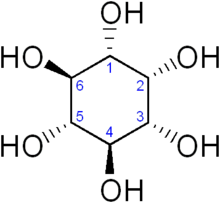 | |
 | |
| Names | |
|---|---|
| IUPAC name
(1R,2S,3r,4R,5S,6s)-cyclohexane-1,2,3,4,5,6-hexol | |
| Other names
cis-1,2,3,5-trans-4,6-Cyclohexanehexol , Cyclohexanehexol, Mouse antialopecia factor, Nucite, Phaseomannite, Phaseomannitol, Rat antispectacled eye factor, and Scyllite (for the structural isomer scyllo-Inositol) | |
| Identifiers | |
3D model (JSmol) |
|
| ChEBI | |
| ChEMBL | |
| ChemSpider | |
| KEGG | |
PubChem CID |
|
| UNII | |
| |
| |
| Properties | |
| C6H12O6 | |
| Molar mass | 180.16 g/mol |
| Density | 1.752 g/cm3 |
| Melting point | 225 to 227 °C (437 to 441 °F; 498 to 500 K) |
| Pharmacology | |
| A11HA07 (WHO) | |
| Hazards | |
| NFPA 704 | |
| Flash point | 143 °C (289 °F; 416 K) |
Except where otherwise noted, data are given for materials in their standard state (at 25 °C [77 °F], 100 kPa). | |
| Infobox references | |
Myo-inositol, or simply inositol, is a carbocyclic sugar that is abundant in brain and other mammalian tissues, mediates cell signal transduction in response to a variety of hormones, neurotransmitters and growth factors and participates in osmoregulation. [2] It is a sugar alcohol with half the sweetness of sucrose (table sugar). It is made naturally in human beings from glucose. Each kidney makes 2g a day; so 4g a day total is made. Other tissues synthesize it too, and the highest concentration is in the brain where it plays an important role making other neurotransmitters, and some steroid hormones bind to their receptors.[3]
Overview
myo-Inositol plays an important role as the structural basis for a number of secondary messengers in eukaryotic cells, the various inositol phosphates. In addition, inositol serves as an important component of the structural lipids phosphatidylinositol (PI) and its various phosphates, the phosphatidylinositol phosphate (PIP) lipids.
Inositol or its phosphates and associated lipids are found in many foods, in particular fruit, especially cantaloupe and oranges.[4] In plants, the hexaphosphate of inositol, phytic acid or its salts, the phytates, serve as phosphate stores in seed, for example in nuts and beans.[5] Phytic acid also occurs in cereals with high bran content. Phytate is, however, not directly bioavailable to humans in the diet, since it is not digestible. Some food preparation techniques partly break down phytates to change this. However, inositol in the form of glycerophospholipids, as found in certain plant-derived substances such as lecithins is well-absorbed and relatively bioavailable.
myo-Inositol (free of phosphate) was once considered a member of the vitamin B complex, called Vitamin B8 in this context. However, because it is produced by the human body from glucose, it is not an essential nutrient.[6]
Isomers and structure
The isomer myo-inositol is a meso compound, and hence optically inactive, because it has a plane of symmetry. For this reason, meso-inositol is an obsolete name for this compound. Besides myo-inositol, the other naturally occurring stereoisomers are scyllo-, muco-, D-chiro-, and neo-inositol, although they occur in minimal quantities in nature. The other possible isomers are L-chiro-, allo-, epi-, and cis-inositol. As their names denote, L- and D-chiro inositol are the only pair of inositol enantiomers, but they are enantiomers of each other, not of myo-inositol.[7]
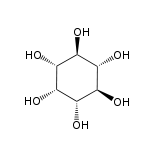 |
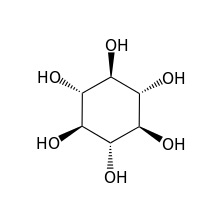 |
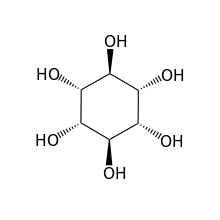 |
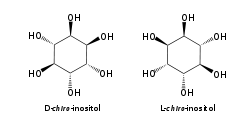 |
| myo- | scyllo- | muco- | chiro- |
 |
 |
 |
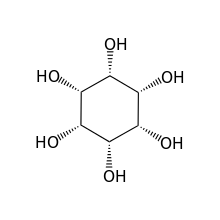 |
| neo- | allo- | epi- | cis- |
In its most stable conformation, the myo-inositol isomer assumes the chair conformation, which moves the maximum number of hydroxyls to the equatorial position, where they are farthest apart from each other. In this conformation, the natural myo isomer has a structure in which five of the six hydroxyls (the first, third, fourth, fifth, and sixth) are equatorial, whereas the second hydroxyl group is axial.[8]
Biosynthesis
myo-Inositol is synthesized from glucose-6-phosphate (G-6-P) in two steps. First, G-6-P is isomerised by an inositol-3-phosphate synthase enzyme (for example, ISYNA1) to myo-inositol 1-phosphate, which is then dephosphorylated by an inositol monophosphatase enzyme (for example, IMPA1) to give free myo-inositol. In humans, most inositol is synthesized in the kidneys, typically in amounts of a few grams per day.[9]
Function
Inositol, phosphatidylinositol and some of their mono- and polyphosphates function as secondary messengers in a number of intracellular signal transduction pathways. They are involved in a number of biological processes, including:
- Insulin signal transduction[10]
- Cytoskeleton assembly
- Nerve guidance (epsin)
- Intracellular calcium (Ca2+) concentration control[11]
- Cell membrane potential maintenance[12]
- Breakdown of fats [13]
- Gene expression[14][15]
In one important family of pathways, phosphatidylinositol 4,5-bisphosphate (PIP2) is stored in cellular membranes until it is released by any of a number of signalling proteins and transformed into various secondary messengers, for example diacylglycerol and inositol triphosphate.[16]
Phytic acid in plants
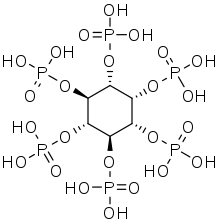
Inositolhexaphosphate, also called phytic acid or IP6, is the principal storage form of phosphorus in many plant tissues, especially bran and seed.[17] Phosphorus and inositol in phytate form are not generally bioavailable to non-ruminant animals because these animals lack the digestive enzyme phytase required to remove the phosphate groups. Ruminants are readily able to digest phytate because of the phytase produced by rumen microorganisms.[18] Moreover, phytic acid also chelates important minerals such as calcium, magnesium, iron, and zinc, making them unabsorbable, and contributing to mineral deficiencies in people whose diets rely highly on bran and seeds for their mineral intake, such as occurs in developing countries.[19][20]
Inositol penta- (IP5), tetra- (IP4), and triphosphate (IP3) are also called "phytates".
Use in explosives manufacture
At the 1936 meeting of the American Chemical Society, professor Edward Bartow of the University of Iowa presented a commercially viable means of extracting large amounts of inositol from the phytic acid naturally present in waste corn. As a possible use for the chemical, he suggested 'inositol nitrate' as a more stable alternative to nitroglycerin.[21] Today, inositol nitrate is used to gelatinize nitrocellulose, thus can be found in many modern explosives and solid rocket propellants.[22]
Counter to road salt
When plants are exposed to increasing concentrations of road salt, the plant cells become dysfunctional and undergo apoptosis, leading to inhibited growth. Inositol pretreatment could reverse these effects.[23][24]
Research and clinical applications
Large doses of inositol have been studied for treatment of depression, but insufficient evidence exists to determine whether this is an effective treatment.[25]
Inositol is effective in the management of preterm babies who have or are at a risk of infant respiratory distress syndrome (RDS).[26]
Inositol is considered a safe and effective treatment for polycystic ovary syndrome (PCOS). It works by increasing insulin sensitivity, which helps to improve ovarian function and reduce hyperandrogenism.[27] It is also shown to reduce the risk of metabolic disease in people with PCOS.[28]
Use as a cutting agent
Inositol has been used as an adulterant or cutting agent for many illegal drugs, such as cocaine, methamphetamine, and sometimes heroin,[29] probably because of its solubility, powdery texture, or reduced sweetness (50%) compared to more common sugars.
Inositol is also used as a stand-in film prop for cocaine in filmmaking.[30]
Nutritional sources
myo-Inositol is naturally present in a variety of foods, although tables of food composition do not always distinguish between lecithin, the bioavailable form, and the unavailable phytate form in grains.[4] Foods containing the highest concentrations of myo-inositol (including its compounds) include fruits, beans, grains, and nuts.[4] Beans and grains, however, contain large amounts of phytate.
References
- ↑ Merck Index, 11th Edition, 4883.
- ↑ Parthasarathy LK, Seelan RS, Tobias C, Casanova MF, Parthasarathy RN (2006). "Mammalian inositol 3-phosphate synthase: its role in the biosynthesis of brain inositol and its clinical use as a psychoactive agent". Sub-Cellular Biochemistry. 39: 293–314. PMID 17121280.
- ↑ Croze ML, Soulage CO (October 2013). "Potential role and therapeutic interests of myo-inositol in metabolic diseases". Biochimie. 95 (10): 1811–27. doi:10.1016/j.biochi.2013.05.011. PMID 23764390.
- 1 2 3 Clements RS, Darnell B (September 1980). "Myo-inositol content of common foods: development of a high-myo-inositol diet". The American Journal of Clinical Nutrition. 33 (9): 1954–67. doi:10.1093/ajcn/33.9.1954. PMID 7416064.
- ↑ "Phytic acid". www.phytochemicals.info. Archived from the original on 2017-08-06. Retrieved 2017-10-02.
- ↑ Reynolds, James E. F. (January 1, 1993). Martindale: The Extra Pharmacopoeia. 30. Pennsylvania: Rittenhouse Book Distributors. p. 1379. ISBN 0-85369-300-5.
An isomer of glucose that has traditionally been considered to be a B vitamin although it has an uncertain status as a vitamin and a deficiency syndrome has not been identified in man
- ↑ Majumder AL, Biswas BB (2006-10-03). Biology of Inositols and Phosphoinositides. Springer Science & Business Media. ISBN 9780387276007.
- ↑ Brady S, Siegel G, Albers RW, Price D (2005-11-11). Basic Neurochemistry: Molecular, Cellular and Medical Aspects. Academic Press. p. 348. ISBN 9780080472072.
- ↑ Parthasarathy LK, Seelan RS, Tobias C, Casanova MF, Parthasarathy RN (2006). "Mammalian inositol 3-phosphate synthase: its role in the biosynthesis of brain inositol and its clinical use as a psychoactive agent". Sub-Cellular Biochemistry. 39: 293–314. PMID 17121280.
- ↑ Larner J (2002). "D-chiro-inositol--its functional role in insulin action and its deficit in insulin resistance". International Journal of Experimental Diabetes Research. 3 (1): 47–60. doi:10.1080/15604280212528. PMC 2478565. PMID 11900279.
- ↑ Gerasimenko JV, Flowerdew SE, Voronina SG, Sukhomlin TK, Tepikin AV, Petersen OH, Gerasimenko OV (December 2006). "Bile acids induce Ca2+ release from both the endoplasmic reticulum and acidic intracellular calcium stores through activation of inositol trisphosphate receptors and ryanodine receptors". The Journal of Biological Chemistry. 281 (52): 40154–63. doi:10.1074/jbc.M606402200. PMID 17074764.
- ↑ Kukuljan M, Vergara L, Stojilkovic SS (February 1997). "Modulation of the kinetics of inositol 1,4,5-trisphosphate-induced [Ca2+]i oscillations by calcium entry in pituitary gonadotrophs". Biophysical Journal. 72 (2 Pt 1): 698–707. Bibcode:1997BpJ....72..698K. doi:10.1016/S0006-3495(97)78706-X. PMC 1185595. PMID 9017197.
- ↑ Rapiejko PJ, Northup JK, Evans T, Brown JE, Malbon CC (November 1986). "G-proteins of fat-cells. Role in hormonal regulation of intracellular inositol 1,4,5-trisphosphate". The Biochemical Journal. 240 (1): 35–40. PMC 1147372. PMID 3103610.
- ↑ Shen X, Xiao H, Ranallo R, Wu WH, Wu C (January 2003). "Modulation of ATP-dependent chromatin-remodeling complexes by inositol polyphosphates". Science. 299 (5603): 112–4. doi:10.1126/science.1078068. PMID 12434013.
- ↑ Steger DJ, Haswell ES, Miller AL, Wente SR, O'Shea EK (January 2003). "Regulation of chromatin remodeling by inositol polyphosphates". Science. 299 (5603): 114–6. doi:10.1126/science.1078062. PMC 1458531. PMID 12434012.
- ↑ 1937–, Mathews, Christopher K., (2000). Biochemistry. Van Holde, K. E. (Kensal Edward), 1928–, Ahern, Kevin G. (3rd ed.). San Francisco, Calif.: Benjamin Cummings. p. 855. ISBN 0805330666. OCLC 42290721.
- ↑ "Phytic acid". www.phytochemicals.info. Archived from the original on 7 March 2018. Retrieved 2 May 2018.
- ↑ Klopfenstein TJ, Angel R, Cromwell G, Erickson GE, Fox DG, Parsons C, Satter LD, Sutton AL, Baker DH (July 2002). "Animal Diet Modification to Decrease the Potential for Nitrogen and Phosphorus Pollution". Council for Agricultural Science and Technology. 21. Archived from the original on 2011-06-11.
- ↑ Hurrell RF (September 2003). "Influence of vegetable protein sources on trace element and mineral bioavailability". The Journal of Nutrition. 133 (9): 2973S–7S. doi:10.1093/jn/133.9.2973S. PMID 12949395.
- ↑ Committee on Food Protection; Food and Nutrition Board; National Research Council (1973). "Phytates". Toxicants Occurring Naturally in Foods. National Academy of Sciences. pp. 363–371. ISBN 978-0-309-02117-3.
- ↑ Laurence, William L. "Corn by-product yields explosive" Archived 2013-05-12 at the Wayback Machine., The New York Times. April 17, 1936. Page 7.
- ↑ Ledgard, Jared. The Preparatory Manual of Explosives, 2007. p. 366.
- ↑ Chatterjee J, Majumder AL (September 2010). "Salt-induced abnormalities on root tip mitotic cells of Allium cepa: prevention by inositol pretreatment". Protoplasma. 245 (1–4): 165–72. doi:10.1007/s00709-010-0170-4. PMID 20559853.
- ↑ Theerakulp P, Gunnula W (2012). "Exogenous Sorbitol and Trehalose Mitigated Salt Stress Damage in Salt-sensitive but not Salt-tolerant Rice Seedlings". Asian Journal of Crop Science. 4 (4): 165–70. doi:10.3923/ajcs.2012.165.170.
- ↑ Taylor MJ, Wilder H, Bhagwagar Z, Geddes J (2004). "Inositol for depressive disorders". The Cochrane Database of Systematic Reviews (2): CD004049. doi:10.1002/14651858.CD004049.pub2. PMID 15106232.
- ↑ Howlett A, Ohlsson A, Plakkal N (February 2015). "Inositol in preterm infants at risk for or having respiratory distress syndrome". The Cochrane Database of Systematic Reviews (2): CD000366. doi:10.1002/14651858.CD000366.pub3. PMID 25927089.
- ↑ Monastra G, Unfer V, Harrath AH, Bizzarri M (January 2017). "Combining treatment with myo-inositol and D-chiro-inositol (40:1) is effective in restoring ovary function and metabolic balance in PCOS patients". Gynecological Endocrinology. 33 (1): 1–9. doi:10.1080/09513590.2016.1247797. PMID 27898267.
- ↑ Nordio M, Proietti E (May 2012). "The combined therapy with myo-inositol and D-chiro-inositol reduces the risk of metabolic disease in PCOS overweight patients compared to myo-inositol supplementation alone". European Review for Medical and Pharmacological Sciences. 16 (5): 575–81. PMID 22774396.
- ↑ "Archived copy". Archived from the original on 2014-09-08. Retrieved 2013-07-21.
- ↑ Golianopoulos, Thomas. "Drug Doubles: What Actors Actually Toke, Smoke and Snort on Camera". Wired Magazine. Archived from the original on 14 May 2012. Retrieved 14 May 2012.
External links
| Wikimedia Commons has media related to Inositol. |
- U.S. National Library of Medicine: Drug Information Portal – Inositol
- Inositol MS Spectrum
- Inositol bound to proteins in the PDB
